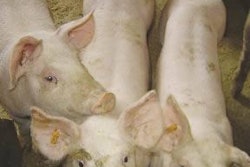
Between 5-10% of all pigs in the member states of the European Union suffer from the behavioural vice known as tail-biting, according to the recently published results of a pan-Europe survey. The actual incidence of bitten tails varies widely from country to country. Observations reported to the survey indicated a range from below 1% to almost 100%, although most were around the 1-2% level.
Also clear from the evidence gathered by the Europeans is that the national figures will be affected by whether or not pigs' tails are docked — in other words, a section is cut off the end of the tail so it is not so easily bitten. Docking has been outlawed in some parts of Europe while remaining legal in others, as the accompanying Figure 1 from the new report illustrates. The effectiveness of this practice where it is still permitted can be judged from an estimate used by the international working group behind the report, that the prevalence of the vice in populations of docked pigs is approximately 3% whereas in un-docked pigs it is between 6% and 10%.
As the authors point out, it is easy to underestimate the real prevalence of tail-biting. Monitoring of tail damage on carcases at the abattoir, for example, often notes only severe cases associated with infection and condemnation. It will not include healed wounds and its accuracy will be further impeded by the on-farm application of docking. Moreover, abattoir checks do not take into account that some pigs will die or are euthanised on the farm if their tail damage is severe or has resulted in a generalised infection.
From a Danish study reported in 2004 it is possible that carcase inspections identify only about half the cases found by a clinical examination on the farm. Other reports have even warned that 30-70% of all pig units have a tail-biting problem of some degree.
Discarded carcase
It is obviously widespread and a welfare issue on the units where it occurs, but is tail-biting also of importance to production economics? Remarks by the working group that undertook the Europe-wide survey say categorically that we should also regard it as an outward sign of poorer growth performance. An important and severe consequence of tails being bitten is reduced weight gain, the authors declare. The decrease may be significant and is likely to continue through the pig's lifetime, although it could be masked at times by treatment with antibiotics administered during an outbreak.
Reduced growth rates seem associated even with relatively minor episodes, while the other extreme of the most severe cases is represented by the total condemnation of the carcase. Tail-biting is categorised throughout the European report as a source of loss as well as of injuries, infections and pain. It is called the most common cause of secondary bacterial spread in pigs and a factor that increases the risk of carcases being discarded.
Even quite small puncture wounds from the biting can quite readily lead to condemnation of the carcase due to pyaemia. Infection introduced at a wounded tail may travel to the vertebrae, causing spinal abscesses that paralyse the pig so it cannot be sent for slaughter and becomes a total loss for the producer. The bacteria additionally may reach the lungs and kidneys, while other investigations have shown that pigs with a bitten tail are also more likely to have suffered damage to their ears.
Focus on docking
All this can be found in the published opinion of an expert panel on animal health and welfare for the European Food Safety Authority (EFSA), after this agency was asked to advise the European Commission on the risks associated with tail- biting in pigs. Of particular interest to the commission had been whether it might be possible to reduce the need for tail docking, in places where this practice was still permitted by legislation.
The EFSA report issued at the end of 2007 looks at the scientific evidence relating not only to the occurrence of the vice and its consequences, but also the actions that could put a stop to tail-biting problems on affected units.
As with many previous studies it is clear from the panel's deliberations that there is not single solution or Magic Bullet that can halt tail-biting in its tracks. Stress is mentioned as a precursor. Hazards leading up to it are reckoned to range from the animals' breed, gender and age to the environment in which they are housed, their health and the way they are fed.PIGI

















